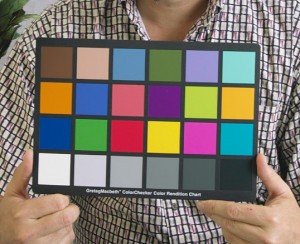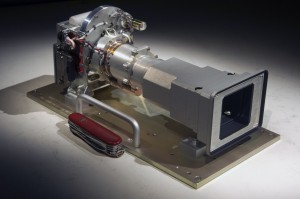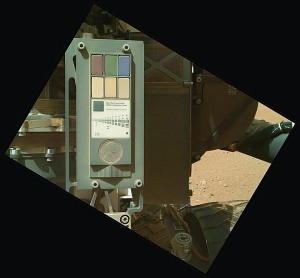All cameras lie. At least a little bit. For that matter so do our eyes. What we want in most cases is a camera to perform in the same characteristics of our eye, although even that can be subjective.
 Back when I would work as a Camera Assistant we would often use a “Macbeth Colorchart” at the head of each scene, and sometimes at each roll of film. It would act as a known “control” that the post production people would know, and therefore be able to tweak color and contrast so that the chart looked like it did to our eye. This was important because color negative film meant that a positive needed to be made and at that step changes could be introduced and of course the goal would to be not to introduce any unwanted changes. Essentially It was “re-exposing” the film, and the chart gave the film lab something to go by on what the cinematographer wanted. Sometimes these charts were shot under “white” light (i.e. light color balanced to the film stock) and then only after it was photographed were gels to change the color of the light applied for the scene to be shot. The goal here was to communicate with the lab, “Just because I put blue gel on the lights doesn’t mean it is a mistake I need you to fix, I want you to “time” your color to the light I shot the chart under, so that my desired color cast is achieved” resulting in this case to a blue cast to he scene.
Back when I would work as a Camera Assistant we would often use a “Macbeth Colorchart” at the head of each scene, and sometimes at each roll of film. It would act as a known “control” that the post production people would know, and therefore be able to tweak color and contrast so that the chart looked like it did to our eye. This was important because color negative film meant that a positive needed to be made and at that step changes could be introduced and of course the goal would to be not to introduce any unwanted changes. Essentially It was “re-exposing” the film, and the chart gave the film lab something to go by on what the cinematographer wanted. Sometimes these charts were shot under “white” light (i.e. light color balanced to the film stock) and then only after it was photographed were gels to change the color of the light applied for the scene to be shot. The goal here was to communicate with the lab, “Just because I put blue gel on the lights doesn’t mean it is a mistake I need you to fix, I want you to “time” your color to the light I shot the chart under, so that my desired color cast is achieved” resulting in this case to a blue cast to he scene.
As the shift to video happened, Macbeth Charts began to lose ground to charts like DSC labs Chroma Du Monde which was more useful when used with a Waveform and Vectorscope, video engineering devices not used in film, but prevalent in video production. according to the DSC labs Website these charts were originally designed by the “US Space Program” which made me think of a color chart I had seen recently photographed in a fairly remote location. “Bradbry Landing” to be exact. No, this isn’t a BBC sequel to “Downtown Abby”, it is the landing site of the Mars Rover Curiosity, or more accurately Mars Science Laboratory (MSL.) It has 17 cameras onboard, some for hazard navigation, some for scientific research. The HazCams are black and white so color reproduction is irrelevant. But some of the cameras shoot in color. We all know Mars is the “Red Planet” but what if you want to correct out that color cast? Well, you shoot a color chart of known colors. NASA calls this a Calibration Target as it does more than just color. Nevertheless it is a pretty simple device. It has 6 color samples. Red, Green, Blue (3 primary colors) 40% gray and 60% gray, and a fluorescent pigment that glows red when hit with ultraviolet light. Pretty simple, especially when you look at the complex charts that DSC produces. I imagine the heavy engineering of the camera’s performance was done here on earth, and this simple chart is just to analyze color cast like that on Mars. The descending bar graphic is adapted from the US
Air force for judging camera resolution. And below that is a 1909 Vdb Penny. what is a coin doing on the chart, you might ask. This chart is mainly for the MALHI camera, which is essentially for close up work, essentially a geologist’s eyes. The penny is a nod to the common practice of a geologist placing a known object within the frame to show scale of object being examined. Rulers work, and are perhaps more scientific, but in choosing a penny NASA is showing a bit of whimsy, something not that bad for a big governmental science and engineering branch to have. Perhaps something we should all keep in mind.
Why a 1909 Vdb penny? The first year the “Lincoln head” penny was produced was 1909 and 2009 was originally the launch date for the rover, and the 100th anniversary made it a good choice apparently. Ultimately the Rover’s launch got delayed to 2011, but by then the decision was made. “VDB” are initials on the bottom of the coin indicating the initials of the designer: Victor D. Brenner.
I find this especially interesting as when I was a kid I dabbled in numismatics, or coin collecting. I got started with some silver quarters my parents gave me, but I remember vividly looking through all the pennies I got over the course of however many months and finding three or four 1909 Vdb pennies myself. At the time they were valued at about $2. Now they are about $15 on ebay for average condition. There is also a 1909 Vdb S penny, which was minted in the San Francisco mint and has a “wheat” back. Those are quite rare and are worth at least a thousand dollars today. Who knows, you might have one in your pocket right now. And you thought pennies were worthless.

MastCam with fixed 34mm f 8.0 lens Notice the Swiss Army knife for perspective. Much like putting a penny next to the object for scale
Now it is not clear to me whether this Calibration Target is available to the other cameras on the Rover, but I think so. The other main camera on the Rover is the “Mast Cam” which provides a human height perspective from Mars and can even capture footage in stereo. The Mast Cam uses the same sensors as the MAHLI does.
The sensors are 1200×1200 pixel (2 megapixel) Bayer pattern sensors. The Mast Cam has two cameras, a “wide angle” (15 degree field of view) 34mm f8 lens with a minimum focus of 2.1 meters and a “telephoto” (5.2 degree field of view) 100mm F10 lens with same minimum focus. Together they can shoot stereo, although with the mismatch in focal lengths means this is only a bonus feature rather than a primary function. Each camera can do 720p video at about 10fps. And for us camera nerds, it has ND filtration as well as IR cut filters (for study of specific wave lengths more than IR contamination I suspect.)
One thing that instantly occurred to me when I first was listening to news reports of Curiosity’s landing, was how the hell do they keep dust of the lenses? Dust has an affinity for front elements here on Earth and I imagine it is only worse on Mars. I don’t know if Curiosity has the ability to blow off dust of its lenses, but I did find out they have an ingenious design to their lens caps. They are transparent. This means that they can take pictures through them if conditions are unfavorable. The optical quality suffers, but the lens is protected. When conditions are clear, they can remove the lens caps for clearer pictures. And like any good photographer, the Rover probably keeps her lenses capped when not in use.
What does this have to do with Calibration Targets and color charts? Well, it helps us get images like the two below. One is “un-white balanced”, and the other is “white balanced” and represents what the surface would look like under Earth lighting. By shooting the Calibration Target first, the engineers can “dial out” any color cast created by the Martian atmosphere. The uncorrected shot, if it had a calibration chart in the frame, would have colors that would not look correct. In the “white balanced” shot, all the colors on the target should look true and accurate, the same as they did back at NASA before it launched.
If these pictures are too small to your liking, here is the link to NASA’s page that has links to some super high res versions. Now I don’t know about you, but I find high res panoramic photos of a foreign planet pretty cool.
So what does this all mean? Well, for one, I plan to tape a 1909 Vdb penny to my Chroma Du Monde chart. Why? there are several reasons. I want to be reminded that whenever I pull my color chart out that somewhere on a different planet millions of miles away, there is a similar chart being used to aid in photography. The penny also reminds me that in the most ordinary mundane things, like a penny, there can be surprises if you just look carefully enough. A good thing to keep in mind in life, as well as photography. Who would have thought that the lowly penny would be the first currency to arrive at another planet? And lastly, no matter how big or important the job is there is always room for some whimsy.
I feel getting a copy of the only coin (of any currency) that is on another planet for $15 on Ebay is a deal if ever I saw one. And in the meantime I am going to start checking my pockets more often. Who knows, there could be a 1909 Vdb S in there with all that loose change.



